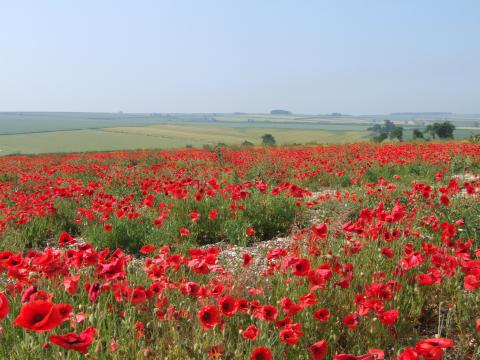TALISMAN and SCARAB followed on from the Boxworth project. The Boxworth project looked at the the effects of pesticide use in cereals on a range of wildlife, including plants, birds, small mammals, and arthropods (insects, mites and spiders). The Boxworth project was a long-term comparison of different farming systems comparing the environmental and ecological side effects of contrasting pesticide regimes. It was done on a single site - ADS Boxworth.
TALISMAN was designed to answer specific questions surrounding new policies relating to the reduction in nitrogen fertiliser and pesticide use. The main objective was to provide robust data on the economic and agronomic issues of reducing pesticide and fertiliser use over a 6-year period on autumn and spring sown rotations. Nitrogen and pesticides were applied at recommended rates, compared to a 50% reduction in nitrogen rates and pesticides either omitted or at half rate or less.
SCARAB was designed to verify and extend the environmental data gained in the Boxworth project to a wider range of crops including oilseeds, root crops and grass leys, and in soil types ranging from clay to sand. The objective of SCARAB was to study the environmental effect of pesticide use. Treatments were applied to half fields over a 6-year rotation. Treatments were - Conventional (label rates of pesticides) + insecticide and a Reduced Input Approach where pesticides were applied at reduced rates or omitted but no insecticides, molluscicides or nematicides.
TALISMAN Key results
Herbicides
- Changing crop rotations to include a wide range of spring sown crops did not result in a reduction in herbicide use compared to rotations of winter crops.
- Weed numbers can increase in association with low-input herbicide use but this was generally unaffected by low-input or conventional rates of nitrogen.
- Reduced competition from poorly established crops often made weed control more difficult in a low-input situation.
Weed seedbanks
- In the alternative rotation consisting of mainly spring crops, seedbanks were hundreds to thousands times greater than the corresponding above ground populations because of the high reproductive capacity of dominant weed species completing their lifecycle.
- Reducing herbicide inputs increased the number of species in the seedbank e.g. 7 to 20 species in the alternative rotation at Boxworth. Developing a diverse and balanced seedbank was difficult due to the increase in the dominant species.
Disease
- Disease control was impaired when fungicide use was reduced.
- Disease levels were more severe under high rates of nitrogen.
Invertebrate pests
- Overall, crop yields were largely unaffected by to low input use of insecticides and molluscicides.
- Profitable reductions in pesticide use were possible provided they were targeted selectively. Small but consistent financial savings from minimising use of insecticides and molluscicides were demonstrated.
Non-target arthropods
- From 66 applications of insecticides or molluscicides there were seven where pitfall traps were apparently affected generally through a reduction in carabid beetles or linyphiid spiders. Catches recovered in three months. Effects were seen on 3 occasions with methiocarb, and on single occasions with cypermethrin, dimethoate, pirimicarb and triazophos.
Year and crop rotation also affected arthropods abundance.
- Invertebrate monitoring in TALISMAN demonstrated limited effects of pesticide application on arthropods. Results suggest that the adoption of low-input pesticide use was less damaging to some invertebrates on some occasions but the effects were transitory and populations recovered. In general variations between years and rotations appeared to have a greater effect on invertebrate fauna than pesticide application.
- There was no evidence to suggest that reduced use of herbicides or nitrogen fertilisers either increased or decreased plant parasitic nematode populations, compared with conventional practice.
Arthropods
- Short-lived effects of insecticides on arthropods within the CFP regime occurred in all fields and years. Following application of some insecticides catches of certain species fell to zero but recovered usually within the season.
- Long term negative effects of CFP were detected in only one out of eight sites – Drayton relating to collembola and the use of organophosphates chlorpyrifos and dimethoate.
Soil microflora
- Pesticides effects showed no clear cut pattern on soil bacteria and fungi, and were highly dependent on soil type and soil condition at the time of application. Effects were seen with more persistent pesticides.
- Fungicides had short term negative effects on soil microbial activity and biomass. Multiple applications of fungicide were often inhibitory to microbial activity.
- The effect of herbicides and insecticides was variable and both positive and negative short term effects were seen on soil microbes.
- After five years of transitory effects of pesticides on soil microbes at one site, High Mowthorpe, microbial biomass was 25% lower under the conventional regime in the 6th year.
Earthworms
- Some short lived effects were seen but these were small compared to the natural variation and difficult to relate to pesticide use.
- Results were consistent with the known toxicity to earthworms of the pesticides used in SCARAB.
Weeds
- Weed populations increased over time and were greater in 75% of fields under RIA.
- Some site specific weeds proliferated under RIA – Capsella bursa pastoris, Polygonum aviculare, Galium aparine and Papaver rhoeas.
Insects
- No insecticides were applied to the RIA
- Insects were implicated in 13 out of 20 cereal crops and 10 out of 20 non-cereal crops. These included cereal aphids, potato aphids, and migratory nematodes in sugar beet.
Disease
- In 30 out of 77 applications, fungicide applications at a reduced rate resulted in disease control as good as that seen using at full rates. No fungicides were applied to sugar beet and only modest reductions were made to blight sprays.
The RISC project was initiated by the Department of agriculture for Northern Ireland (DANI) and done in parallel with TALISMAN.





